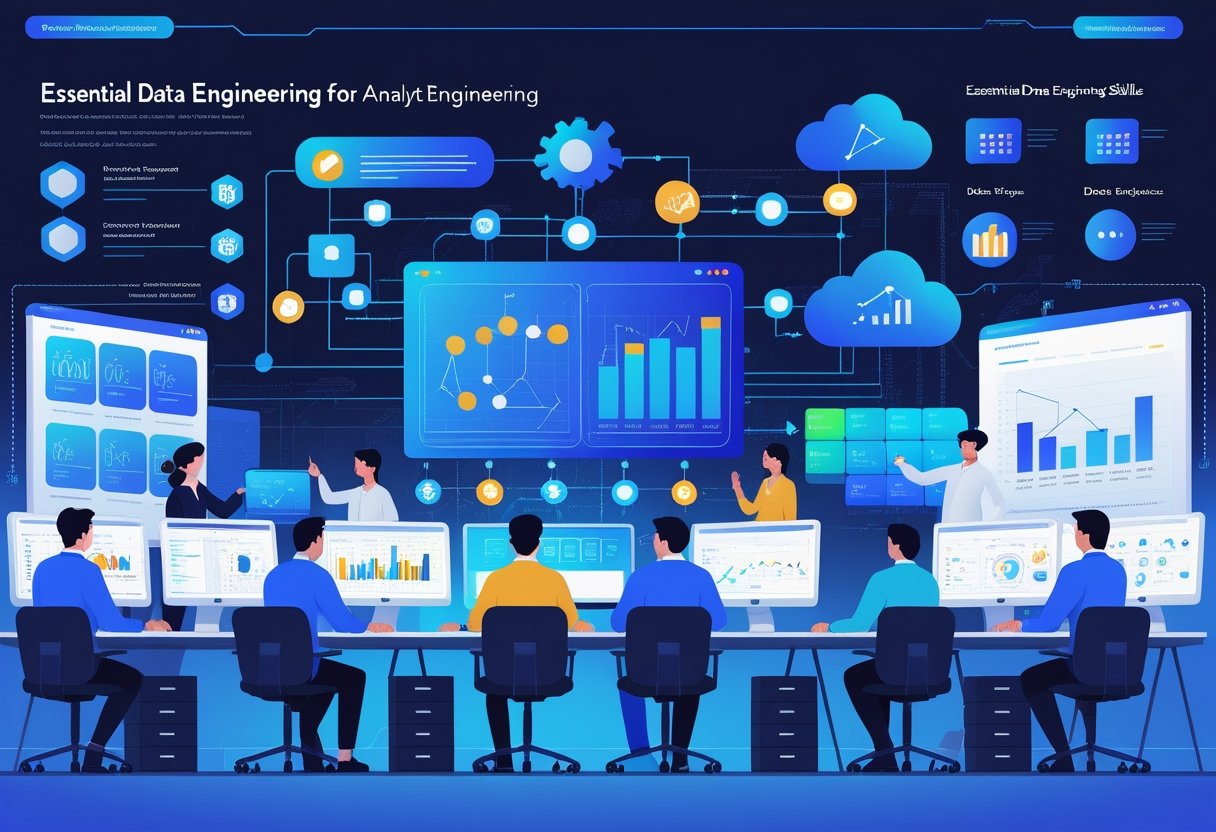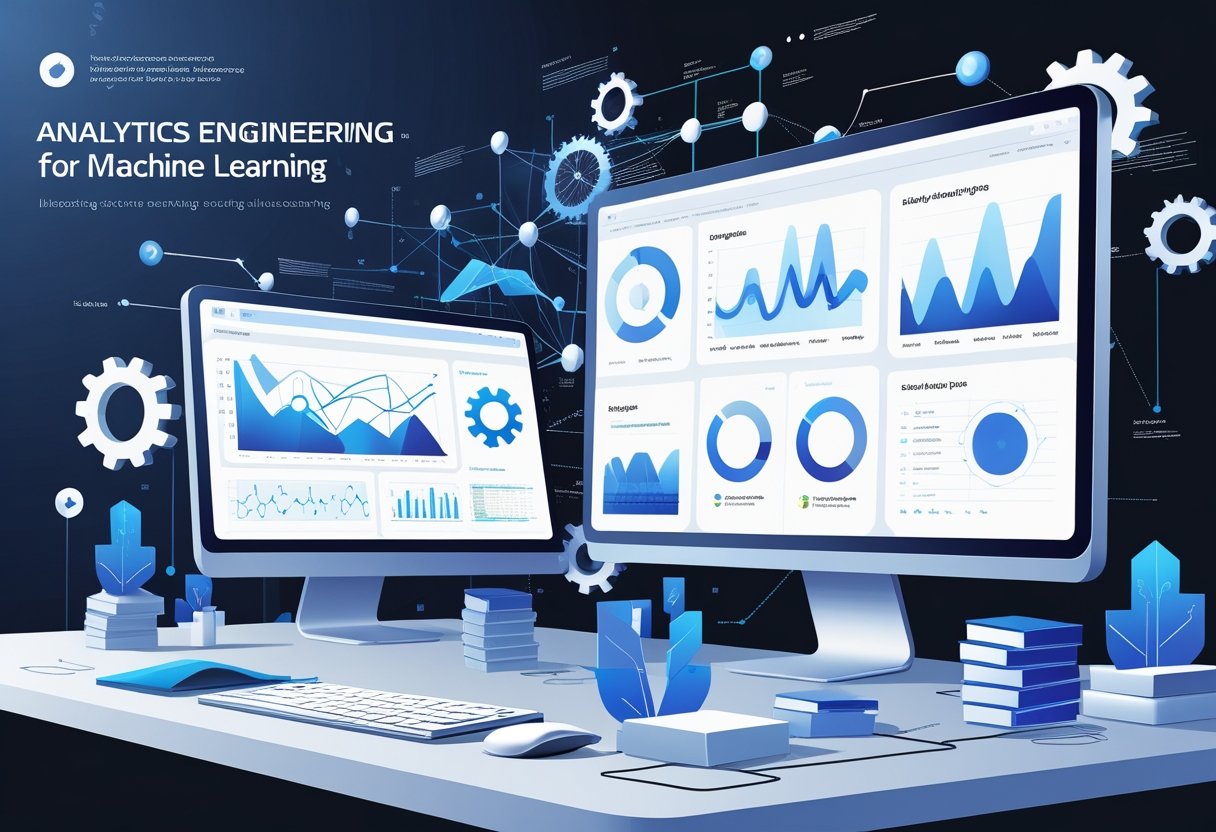Analytics engineering has emerged as one of the most critical roles in modern data organizations, bridging the gap between raw data and actionable business insights. Analytics engineers focus on providing clean data sets to end users while using software engineering best practices to maintain reliable analytics code. This specialized field combines elements of data engineering, data analysis, and software development to create robust data transformation workflows that power business decisions.

The role continues to evolve rapidly as organizations recognize the value of dedicated analytics engineering teams. Analytics engineering practitioners are taking on varied responsibilities across different companies, with some moving toward traditional data engineering tasks while others interface more closely with business stakeholders. This flexibility makes analytics engineering an attractive career path for professionals who want to work at the intersection of technology and business strategy.
Mastering analytics engineering requires understanding core principles, developing technical skills, and staying current with industry trends. This guide covers everything from building scalable data pipelines and managing data transformations to implementing machine learning workflows and collaborating effectively with cross-functional teams. Whether someone is starting their analytics engineering journey or looking to advance their existing skills, this comprehensive resource provides practical knowledge for success in this dynamic field.
Key Takeaways
- Analytics engineers bridge data engineering and analysis by creating clean datasets using software engineering practices
- Success requires mastering data pipelines, transformation tools, and collaboration with both technical and business teams
- The field continues evolving with AI integration and emerging technologies requiring continuous skill development
Core Principles of Analytics Engineering

Analytics engineering bridges the gap between raw data and business insights by combining data engineering skills with analytical thinking. This discipline focuses on transforming data into reliable, accessible formats that drive decision-making across organizations.
Defining Analytics Engineering
Analytics engineering emerged as a distinct field that sits between traditional data engineering and data analysis. The first written mention of analytics engineering appeared in early 2019, marking the beginning of a rapidly growing discipline.
Analytics engineers focus on the middle layer of the data stack. They take raw data that data engineers have collected and transform it into clean, organized datasets that analysts can use.
The role involves three main activities:
- Data modeling to structure information logically
- Data transformation using SQL and other tools
- Data documentation to ensure others understand the datasets
Unlike traditional data engineering, analytics engineering emphasizes business context. Analytics engineers must understand how different departments use data to make decisions.
They work with tools like dbt, SQL, and cloud platforms to build scalable data models. These models serve as the foundation for reports, dashboards, and other analytical products.
The Role of the Analytics Engineer
Analytics engineers serve as translators between technical data teams and business users. They understand both the technical aspects of data systems and the business needs that drive analytical requirements.
Primary responsibilities include:
- Building and maintaining data models
- Creating documentation for datasets
- Ensuring data quality and reliability
- Collaborating with analysts and stakeholders
Analytics engineers spend most of their time writing SQL queries and building transformations. They create reusable data models that multiple teams can access for their analytical needs.
The role requires strong technical skills in SQL, version control, and data modeling. Analytics engineers also need business acumen to understand which metrics matter most to different departments.
They often act as consultants within their organizations. When business users need new datasets or metrics, analytics engineers design and implement the necessary data models.
Analytics Engineering vs Data Engineering
While both roles work with data, analytics engineering and data engineering serve different purposes in the data pipeline. Understanding these differences helps organizations structure their data teams effectively.
Data Engineering Focus:
- Building data pipelines and infrastructure
- Managing data ingestion from various sources
- Ensuring system scalability and performance
- Working with streaming data and real-time processing
Analytics Engineering Focus:
- Transforming data for analytical use cases
- Creating business-friendly data models
- Documenting datasets for end users
- Optimizing queries for reporting tools
Data engineers typically work closer to the source systems and raw data. They focus on moving large volumes of data efficiently and reliably.
Analytics engineers work closer to the business users and final analytical products. They focus on making data understandable and accessible for decision-making.
| Aspect | Data Engineering | Analytics Engineering |
|---|---|---|
| Primary Tools | Python, Spark, Kafka | SQL, dbt, BI tools |
| Data Focus | Raw, unstructured | Clean, modeled |
| Scale | Big data systems | Analytical datasets |
| Users | Technical teams | Business analysts |
Both roles complement each other in modern data organizations. Data engineers provide the foundation, while analytics engineers build the analytical layer on top.
Essential Data Engineering Skills for Analytics Engineering

Analytics engineers need strong technical foundations in SQL for data transformation, programming languages for workflow automation, and collaborative development practices. These core competencies enable effective data pipeline management and team coordination.
Foundational SQL Techniques
SQL forms the backbone of analytics engineering work. Essential data engineering skills emphasize SQL mastery as a fundamental requirement for 2025.
Analytics engineers must write complex queries involving multiple joins, window functions, and CTEs (Common Table Expressions). They need expertise in query optimization techniques like proper indexing and execution plan analysis.
Advanced SQL operations include:
- Recursive queries for hierarchical data
- Pivot and unpivot operations
- Advanced aggregation functions
- Performance tuning and query optimization
Modern analytics platforms require knowledge of both traditional SQL databases and cloud-based solutions like Snowflake, BigQuery, and Redshift. Each platform has unique syntax and optimization strategies.
Data modeling skills complement SQL expertise. Analytics engineers design dimensional models, implement slowly changing dimensions, and create efficient star and snowflake schemas.
Python and R for Analytics Workflows
Programming languages extend SQL capabilities for complex data engineering workflows. Python remains dominant in 2025 due to its versatility and rich ecosystem.
Key Python libraries for analytics engineering:
- Pandas for data manipulation and analysis
- SQLAlchemy for database connections
- Airflow for workflow orchestration
- DBT for data transformation pipelines
Python enables automation of repetitive tasks like data quality checks, automated testing, and pipeline monitoring. Analytics engineers write scripts to handle data validation, error handling, and alerting systems.
R complements Python for statistical analysis and advanced analytics. Many organizations use R for specialized statistical modeling and data visualization tasks that require sophisticated mathematical operations.
Both languages integrate seamlessly with version control systems and CI/CD pipelines, enabling robust data engineering workflows.
Version Control and Collaboration
Version control systems like Git are essential for managing analytics code and collaborating with team members. Analytics engineers track changes to SQL scripts, Python code, and configuration files.
Git workflows for analytics teams:
- Feature branches for new development
- Pull requests for code review
- Merge strategies for production deployment
- Rollback procedures for quick fixes
Documentation practices ensure team knowledge sharing. Analytics engineers maintain README files, code comments, and data dictionaries. They document data lineage, transformation logic, and business rules.
Collaborative tools like GitHub, GitLab, or Bitbucket provide platforms for code review and team coordination. These platforms integrate with deployment pipelines and testing frameworks.
Team collaboration extends beyond code management. Analytics engineers participate in data governance committees, establish coding standards, and mentor junior team members on best practices.
Building and Managing Scalable Data Pipelines

Modern data engineering frameworks require robust pipelines that handle increasing data volumes efficiently. Organizations must choose between batch and streaming architectures, select appropriate transformation strategies, and implement reliable orchestration systems.
Types of Data Pipelines
Data pipelines fall into three main categories based on processing patterns and timing requirements. Batch pipelines process large volumes of data at scheduled intervals, typically hourly or daily. They work well for historical analysis and reporting where real-time updates are not critical.
Streaming pipelines handle continuous data flows in real-time or near real-time. These pipelines process events as they occur, making them ideal for fraud detection, monitoring systems, and live dashboards.
Micro-batch pipelines combine elements of both approaches. They collect small batches of data over short time windows, usually seconds or minutes. This approach balances processing efficiency with near real-time capabilities.
| Pipeline Type | Processing Speed | Use Cases | Complexity |
|---|---|---|---|
| Batch | Hours to days | Reports, analytics | Low |
| Streaming | Milliseconds | Monitoring, alerts | High |
| Micro-batch | Minutes | Dashboards, ETL | Medium |
The choice depends on business requirements, data volume, and latency tolerance. Many organizations use hybrid approaches that combine multiple pipeline types for different data processing needs.
ETL vs ELT Processes
Traditional ETL extracts data from sources, transforms it during processing, then loads it into target systems. This approach works well with structured data and limited storage capacity. ETL requires defining transformation logic upfront and processes data before storage.
ELT processes have become the backbone of cloud-native analytics platforms. ELT loads raw data first, then transforms it within the target system. This approach leverages the processing power of modern data warehouses and cloud platforms.
Key differences:
- Storage requirements: ETL needs less storage but more processing power upfront
- Flexibility: ELT allows multiple transformations of the same raw data
- Speed: ELT can be faster for large datasets using cloud computing power
- Cost: ELT may reduce processing costs but increase storage costs
ELT works particularly well with data lakes and cloud data warehouses like Snowflake or BigQuery. Organizations can store all raw data and apply different transformations as business needs evolve.
The choice between ETL and ELT depends on data volume, storage costs, processing capabilities, and business requirements for data accessibility.
Orchestration Tools
Data pipeline orchestration manages workflow scheduling, dependency handling, and error recovery across complex data processing tasks. Apache Airflow remains the most popular open-source orchestration platform, offering flexible DAG-based workflows and extensive integrations.
Cloud-native options include AWS Step Functions, Azure Data Factory, and Google Cloud Composer. These services provide managed orchestration with built-in monitoring and scaling capabilities.
Key orchestration features:
- Dependency management: Ensures tasks run in correct order
- Error handling: Automatic retries and failure notifications
- Monitoring: Real-time visibility into pipeline status
- Scaling: Dynamic resource allocation based on workload
Modern orchestration tools support both batch and streaming workflows. They integrate with popular data processing frameworks like Spark and data storage systems including data lakes and warehouses.
Building scalable data pipelines requires orchestration that can handle increasing data volumes and complexity. Tools should provide version control, testing capabilities, and integration with existing data infrastructure.
The right orchestration platform reduces operational overhead while improving pipeline reliability and maintainability.
Data Integration and Data Lakes

Data integration forms the backbone of modern analytics by connecting disparate data sources into unified storage systems. Modern data lake architectures enable organizations to store vast amounts of structured and unstructured data while maintaining flexibility for diverse analytical workloads.
Principles of Data Integration
Data integration combines information from multiple sources into a single, coherent view. This process involves extracting data from various systems, transforming it into compatible formats, and loading it into target destinations.
Extract, Transform, Load (ETL) represents the traditional approach. Data undergoes transformation before reaching its destination. This method ensures data quality but can create processing bottlenecks.
Extract, Load, Transform (ELT) reverses this sequence. Raw data loads directly into the target system before transformation occurs. This approach leverages modern computing power and storage capabilities.
Key integration patterns include:
- Batch processing for large data volumes
- Stream processing for real-time analytics
- Change data capture for incremental updates
- API-based integration for cloud services
Data engineers must address schema evolution, data lineage tracking, and error handling. These considerations ensure reliable data pipelines that support business operations.
Modern Data Lake Architectures
Data lakes store raw data in its native format until needed for analysis. Unlike traditional databases, they accommodate structured, semi-structured, and unstructured data types simultaneously.
Object storage forms the foundation of most data lakes. Technologies like Amazon S3, Azure Data Lake Storage, and Google Cloud Storage provide scalable, cost-effective storage solutions.
The lakehouse architecture combines data lake flexibility with data warehouse performance. Delta Lake technology enables ACID transactions, schema enforcement, and time travel capabilities on data lake storage.
Modern architectures implement multiple zones:
| Zone | Purpose | Data Quality |
|---|---|---|
| Bronze | Raw ingestion | Unprocessed |
| Silver | Cleaned data | Validated |
| Gold | Business-ready | Aggregated |
Data cataloging becomes essential as lake size grows. Metadata management tools help users discover and understand available datasets.
Security controls include encryption, access policies, and audit logging. These measures protect sensitive information while enabling self-service analytics.
Data Warehousing Concepts
Data warehouses organize information specifically for analytical queries and reporting. They use dimensional modeling to structure data for efficient business intelligence operations.
Star schemas center around fact tables containing measurable events. Dimension tables provide descriptive context like time, geography, or product details. This design optimizes query performance for common analytical patterns.
Slowly changing dimensions handle data that evolves over time. Type 1 overwrites old values, Type 2 creates new records, and Type 3 maintains both current and previous states.
Cloud data warehouses like Snowflake, BigQuery, and Redshift separate compute from storage. This architecture enables elastic scaling and pay-per-use pricing models.
Columnar storage accelerates analytical workloads by reading only required columns. Compression techniques reduce storage costs and improve query speeds.
Data warehouses implement OLAP cubes for multidimensional analysis. These pre-aggregated structures enable rapid slice-and-dice operations across business dimensions.
Modern approaches blur traditional boundaries between lakes and warehouses. Unified platforms provide both storage flexibility and analytical performance within single environments.
Data Processing and Transformation

Data transformation patterns form the backbone of modern analytics engineering, converting raw information into analysis-ready datasets. Effective data processing workflows ensure data quality through systematic cleaning, validation, and optimization techniques that reduce pipeline processing time by up to 83%.
Data Cleaning and Quality Assurance
Data quality issues affect up to 30% of organizational datasets. Analytics engineers must implement systematic validation checks at each processing stage.
Common data quality problems include:
- Missing values and null fields
- Duplicate records across systems
- Inconsistent formatting standards
- Outliers and anomalous values
Data profiling tools identify these issues before transformation begins. Engineers use statistical methods to detect outliers and establish acceptable value ranges for each field.
Automated validation rules catch errors during processing. These rules check data types, field lengths, and business logic constraints. Failed records get flagged for manual review or automatic correction.
Quality metrics track improvement over time:
- Completeness rates by field
- Duplicate percentage
- Format compliance scores
- Business rule violations
Data lineage documentation helps trace quality issues back to their source systems. This visibility enables teams to fix problems at their origin rather than applying band-aid solutions.
Transformation Workflows
Modern data engineering workflows follow either ETL or ELT patterns depending on processing requirements and infrastructure capabilities.
ETL workflows transform data before loading into target systems. This approach works well for:
- Batch processing scenarios
- Complex business logic requirements
- Systems with limited compute resources
ELT workflows leverage cloud warehouse computing power for transformations. Organizations choose ELT when they need:
- Real-time processing capabilities
- Scalable transformation compute
- Schema-on-read flexibility
Transformation logic includes structural changes like normalization and content modifications such as calculations or enrichment. Engineers design idempotent transformations that produce identical results when rerun.
Key transformation types:
- Schema mapping: Converting between different data structures
- Data type conversions: Ensuring consistent formats
- Business calculations: Deriving new metrics and KPIs
- Data enrichment: Adding external reference data
Version control systems track all transformation logic changes. This enables teams to roll back problematic updates and maintain consistent processing across environments.
Performance Optimization Techniques
Processing performance directly impacts data freshness and system costs. Advanced data engineering techniques reduce resource consumption while maintaining data quality.
Partitioning strategies divide large datasets into manageable chunks. Time-based partitioning works well for event data, while hash partitioning distributes records evenly across processing nodes.
Columnar storage formats like Parquet reduce I/O overhead by 60-80%. These formats compress better and enable efficient column-level operations during analysis.
Optimization techniques include:
- Parallel processing across multiple cores
- Incremental updates instead of full reloads
- Caching frequently accessed datasets
- Query pushdown to source systems
Memory management prevents out-of-memory errors during large transformations. Engineers configure appropriate buffer sizes and implement streaming processing for datasets exceeding available RAM.
Monitoring tools track processing metrics like execution time, memory usage, and error rates. This data helps identify bottlenecks and guide optimization efforts.
Performance monitoring metrics:
- Records processed per second
- Memory utilization peaks
- Network I/O throughput
- Error and retry rates
Analytics Engineering for Machine Learning

Analytics engineers create the data foundation that machine learning models need to work properly. They build pipelines that transform raw data into clean features and set up systems that feed data to models in real-time.
Feature Engineering
Feature engineering turns raw data into useful inputs for machine learning algorithms. Analytics engineers design automated pipelines that create, test, and maintain features at scale.
Data Transformation Pipelines
Engineers build systems that clean messy data and fix missing values. They create calculated fields like ratios, averages, and time-based features that help models learn patterns.
Feature Store Architecture
A feature store keeps all engineered features in one place. This lets data science teams reuse features across different projects instead of building them again.
| Feature Type | Example | Use Case |
|---|---|---|
| Numerical | Customer age, purchase amount | Regression models |
| Categorical | Product category, user type | Classification tasks |
| Time-based | Days since last purchase | Trend analysis |
Automated Feature Creation
Modern systems can create features automatically using code templates. Engineers set up rules that generate new features when new data arrives.
Feeding Data to Machine Learning Models
Analytics engineers build the systems that deliver clean, formatted data to machine learning models. They create batch processing for training and real-time streams for predictions.
Training Data Preparation
Engineers design pipelines that split data into training, validation, and test sets. They make sure data stays consistent and remove any information that could cause models to cheat.
Data Validation Systems
Quality checks run automatically to catch problems before bad data reaches models. These systems check for missing values, unexpected formats, and data that looks very different from normal.
Batch vs Streaming Architecture
Batch systems process large amounts of data at scheduled times. Streaming systems handle data as it arrives for immediate model predictions.
Engineers often use tools like machine learning mastery frameworks to build reliable data pipelines.
Real-Time ML Integration
Real-time integration lets machine learning models make predictions as new data arrives. Analytics engineers build the infrastructure that connects live data streams to trained models.
Stream Processing Setup
Engineers use tools like Apache Kafka to move data quickly from sources to models. They set up buffers and queues that handle traffic spikes without losing data.
Model Serving Infrastructure
APIs and microservices wrap trained models so applications can request predictions easily. Engineers monitor response times and scale resources when traffic increases.
Data Consistency Management
Real-time systems must handle data that arrives out of order or gets delayed. Engineers build logic that waits for complete records and handles missing pieces gracefully.
Platforms like Databricks help unify data engineering and analytics for machine learning workflows.
Effective Data Analysis Strategies

Analytics engineers must establish systematic approaches to transform raw data into actionable business insights. Strategic planning for analytical workflows, standardized business intelligence practices, and maintaining data integrity form the foundation of successful data analysis operations.
Designing for Analytical Insights
Analytics engineers should structure data pipelines with specific analytical outcomes in mind. This approach ensures that data transformations support business decision-making rather than creating generic datasets.
Query Performance Optimization represents a critical design consideration. Engineers must index frequently filtered columns and partition large tables by date or business unit. These techniques reduce query execution time from hours to minutes.
Data modeling decisions directly impact analytical capabilities. Star schemas work best for reporting dashboards, while normalized structures suit operational analytics. Engineers should choose the appropriate model based on query patterns and user requirements.
Aggregation Strategies help analysts access pre-calculated metrics quickly. Daily, weekly, and monthly rollups eliminate the need for complex joins during analysis. This preparation accelerates dashboard loading and improves user experience.
Dimensional modeling techniques enable flexible analysis across multiple business contexts. Engineers create fact tables containing measurable events and dimension tables with descriptive attributes. This structure supports various analytical perspectives without data duplication.
Business Intelligence Best Practices
Business intelligence implementation requires standardized approaches to metric definition and calculation logic. Analytics engineers must establish consistent formulas across all reporting tools to prevent conflicting results.
Metric Governance ensures all stakeholders use identical definitions for key performance indicators. Engineers document calculation methods, data sources, and refresh schedules in centralized repositories. This documentation prevents misinterpretation and builds trust in analytical outputs.
Data visualization standards improve communication effectiveness. Engineers should establish color palettes, chart types, and formatting rules that align with organizational branding. Consistent visual elements help users interpret information quickly.
Self-Service Analytics capabilities reduce dependency on technical teams. Engineers create user-friendly interfaces with drag-and-drop functionality for common analysis tasks. These tools empower business users to explore data independently while maintaining data quality standards.
Automated alerting systems notify stakeholders when metrics exceed predefined thresholds. Engineers configure these alerts to trigger appropriate responses without overwhelming users with false positives.
Ensuring Data Consistency in Analysis
Data consistency across analytical workflows prevents contradictory insights and maintains stakeholder confidence. Analytics engineers implement validation rules and monitoring systems to identify discrepancies before they impact business decisions.
Data Quality Checks should run automatically after each transformation step. Engineers create tests that verify row counts, null values, and business rule compliance. Failed tests trigger alerts and prevent unreliable data from reaching analytical tools.
Version control for analytical code ensures reproducible results. Engineers track changes to transformation logic and maintain historical versions for audit purposes. This practice enables rollback capabilities when errors occur.
Cross-Platform Validation confirms that identical metrics produce consistent results across different tools. Engineers compare outputs from data warehouses, business intelligence platforms, and custom applications. Discrepancies indicate underlying data or logic issues that require immediate attention.
Reference data management maintains consistency in categorical values and lookup tables. Engineers establish master data sources for customer segments, product categories, and geographical regions. Centralized reference data prevents analytical fragmentation across business units.
Project Management and Collaboration in Analytics Engineering
Effective project management in analytics engineering requires structured planning frameworks, clear stakeholder communication channels, and modern collaboration tools that enable teams to deliver data solutions on time and within scope.
Planning and Tracking Progress
Analytics project management involves coordinating resources, setting clear objectives, and implementing effective processes for successful execution. Analytics engineering projects require specialized planning approaches that account for data complexity and technical dependencies.
Teams should break down analytics projects into discrete phases. These include data discovery, pipeline development, testing, and deployment phases.
Key Planning Elements:
- Scope Definition: Clearly define data sources, transformation requirements, and output specifications
- Timeline Creation: Account for data validation, testing cycles, and stakeholder review periods
- Resource Allocation: Assign technical resources based on skill requirements and availability
- Risk Assessment: Identify potential data quality issues, technical blockers, and dependency risks
Progress tracking requires both technical and business metrics. Technical metrics include pipeline completion rates, test coverage, and data quality scores.
Business metrics focus on stakeholder satisfaction and project value delivery. Teams should establish regular checkpoint meetings to review progress against planned milestones.
Modern project management tools help teams visualize progress through dashboards and automated reporting. These tools integrate with development workflows to provide real-time project status updates.
Stakeholder Communication
Analytics engineering projects involve multiple stakeholders with varying technical backgrounds. Effective communication bridges the gap between technical teams and business users who will consume the data products.
Regular stakeholder meetings should focus on business outcomes rather than technical implementation details. Teams should translate technical progress into business value terms that stakeholders understand.
Communication Framework:
- Weekly Status Updates: Share completion percentages, upcoming milestones, and any blockers
- Demo Sessions: Show working prototypes and gather feedback on data outputs
- Documentation: Maintain clear documentation of data models, business logic, and usage guidelines
Teams should establish clear communication channels for different types of interactions. Technical discussions happen in development tools while business conversations occur through established meeting cadences.
Stakeholder feedback loops ensure delivered solutions meet business requirements. Early and frequent feedback prevents costly rework during later project phases.
Collaboration Tools and Practices
Collaborative analytics enables broad organizational participation in data analytics through business intelligence software and collaboration tools. Modern analytics engineering teams rely on integrated toolchains that support both technical development and business collaboration.
Essential Collaboration Features:
- Team Workspaces: Shared environments with appropriate permissions and security controls
- Reusable Workflows: Datasets and analyses that teams can save and reuse across projects
- Single Source of Truth: Centralized data access ensuring everyone uses consistent data versions
- Built-in Communication: Chat integration for questions, comments, and feedback requests
Development teams use version control systems to collaborate on code and track changes. These systems integrate with project management tools to link code changes with specific project tasks.
Business users need intuitive interfaces to explore data and provide feedback. Visual data modeling capabilities allow non-technical stakeholders to participate in data model design discussions.
The most effective teams combine technical collaboration tools with business-friendly interfaces. This approach ensures technical excellence while maintaining stakeholder engagement throughout project lifecycles.
Continuous Learning and Skill Development
Analytics engineers must actively engage in practical exercises, competitive challenges, and collaborative learning environments to stay current with rapidly evolving technologies. Building expertise requires hands-on practice with real data problems and connecting with other professionals in the field.
Exercises and Hands-on Learning
Practice builds proficiency faster than theoretical study alone. Analytics engineers should work through structured exercises that mirror real-world scenarios.
Start with SQL challenges on platforms like HackerRank or LeetCode. These exercises cover window functions, complex joins, and query optimization. Practice daily for 30-60 minutes to build muscle memory.
Data modeling exercises help engineers understand dimensional modeling concepts. Create star schemas and snowflake schemas using sample datasets. Work with tools like dbt to practice transformations.
Set up personal projects using cloud platforms like AWS or Google Cloud. Build end-to-end data pipelines from ingestion to visualization. This hands-on experience teaches system integration skills.
Version control practice is essential for modern analytics work. Use Git to manage code changes in personal projects. Learn branching strategies and collaboration workflows.
Work with different data sources including APIs, CSV files, and databases. Each source type presents unique challenges that build technical versatility.
Participating in Competitions
Kaggle competitions offer structured challenges with real datasets and clear success metrics. Analytics engineers can compete in data science competitions to practice machine learning implementation.
Join hackathons focused on data analytics and business intelligence. These events typically last 24-48 hours and require rapid prototyping skills. Teams work together to solve business problems using data.
dbt community challenges provide opportunities to practice modern data transformation techniques. These competitions focus specifically on analytics engineering skills rather than pure data science.
Participate in SQL competitions on platforms like SQLBolt or Mode Analytics. These contests test query writing speed and accuracy under time pressure.
Open source contributions count as competitive learning experiences. Submit pull requests to analytics tools like Apache Airflow or dbt. This builds both technical skills and professional credibility.
Industry-specific competitions like those hosted by finance or healthcare organizations provide domain expertise alongside technical practice.
Building a Learning Community
Professional networks accelerate skill development through knowledge sharing and mentorship opportunities. Join analytics engineering communities on platforms like Slack, Discord, and Reddit.
Connect with other learners through local meetups and professional organizations. Many cities have data engineering or analytics groups that meet monthly. These gatherings offer networking and learning opportunities.
Online study groups provide accountability and diverse perspectives on complex topics. Form groups with colleagues or find existing ones through professional platforms like LinkedIn.
Share knowledge through blog posts, tutorials, or speaking at conferences. Teaching others reinforces personal understanding while building professional reputation.
Mentorship relationships benefit both parties in the learning process. Experienced engineers can guide newcomers while staying current with emerging technologies and fresh perspectives.
Participate in continuous learning approaches that emphasize consistent skill development over time. Create learning schedules that include reading industry publications, watching webinars, and completing online courses.
Follow thought leaders on social media platforms like Twitter and LinkedIn. Many experts share insights about new tools, best practices, and industry trends that keep learners informed about the evolving field.
Future Trends and Evolving Best Practices
Analytics engineering continues to transform as AI tools reshape traditional workflows and organizations invest heavily in data infrastructure. Modern data teams are adopting hybrid organizational models while prioritizing data quality and self-service capabilities.
Evolving Data Engineering Workflows
AI is augmenting data teams rather than replacing them, with 70% of analytics professionals now using AI for code development. These tools help generate SQL queries, write documentation, and debug pipeline issues.
Data teams spend 57% of their time maintaining and organizing datasets. This hasn’t changed significantly despite AI adoption. However, AI tools are making specific tasks more efficient.
Key workflow changes include:
- Code generation: Teams use ChatGPT, Claude, and Gemini for analytics development
- Documentation automation: 50% of professionals leverage AI for metadata creation
- Pipeline debugging: AI helps identify and resolve data quality issues faster
Organizations are implementing hybrid team structures. Teams organize by both business function and technical specialty. This approach helps data professionals embed deeper within business units.
Data quality remains the top challenge for 56% of teams. Poor data quality creates trust issues that affect all downstream systems and AI models.
Innovation in Data Strategy
Data budgets are growing significantly after a period of economic caution. Thirty percent of organizations reported budget increases in 2025, compared to just 9% the previous year.
Investment priorities focus on:
| Area | Investment Level | Purpose |
|---|---|---|
| AI tooling | 45% increasing investment | Code development and automation |
| Data quality tools | 38% increasing investment | Trust and reliability |
| Semantic layers | 27% increasing investment | Natural language queries |
Organizations want to enable non-technical users to work with data. Nearly 65% of teams believe this would improve data value and efficiency. Self-serve analytics becomes a strategic priority.
Data teams feel valued but lack clear organizational goals. Leaders must define specific metrics and expectations for data team impact.
Trust in data remains the foundation of success. Teams prioritize accuracy, transparency, and governance over speed or convenience.
Emerging Tools and Platforms
Specialized AI tools built into development platforms are gaining adoption. About 25% of teams use these integrated solutions instead of general-purpose LLMs.
Platform evolution includes:
- Context-aware AI: Tools that understand existing codebases and metadata
- Natural language interfaces: 52% of teams want to query data conversationally
- Embedded analytics: AI features integrated directly into data platforms
Edge computing and explainable AI systems are reshaping how organizations extract value from data. These technologies enable real-time processing and transparent decision-making.
Teams use semantic layers to improve AI query accuracy. Research shows semantic layers generate more reliable results than vanilla SQL generation for natural language queries.
Cloud-native solutions continue expanding beyond tech companies. Financial services and healthcare organizations now represent 25% of the analytics engineering community. These regulated industries need specialized compliance and governance features.
Frequently Asked Questions
Analytics engineering professionals often encounter specific challenges when building data transformation pipelines, implementing governance frameworks, and integrating AI tools into their workflows. These questions address practical implementation strategies, team structures, and emerging technologies that shape modern data organizations.
What are the prerequisites for excelling in analytics engineering as described in ‘The Definitive Guide’?
Analytics engineers need strong SQL skills as their foundation. They must understand data modeling concepts and dimensional modeling techniques.
Python or R programming knowledge helps with advanced transformations. Git version control experience enables collaborative development workflows.
Business stakeholder communication skills prove essential. Analytics engineers translate technical concepts into business value propositions.
Cloud platform familiarity with AWS, Azure, or GCP supports modern data stack implementations. Understanding of data warehousing concepts like star schemas and fact tables guides effective modeling decisions.
How does the guide suggest structuring an analytics team for maximum efficiency?
Analytics engineering teams increasingly adopt hybrid organizational models. These structures combine functional specialization with business area alignment.
Data engineers focus on pipeline infrastructure and raw data ingestion. Analytics engineers handle data transformation and modeling layers.
Data analysts concentrate on reporting and stakeholder enablement. This separation allows each role to develop deep expertise in their domain.
Cross-functional collaboration happens through shared tools and documentation standards. Teams embed within business units while maintaining technical consistency across the organization.
What are the latest tools and technologies recommended for analytics engineering in the guide?
Modern analytics stacks center around cloud data warehouses like Snowflake, BigQuery, and Redshift. These platforms provide scalable compute and storage separation.
dbt transforms raw data using SQL-based modeling approaches. Git integration enables version control and collaborative development workflows.
Data orchestration tools like Airflow and Prefect manage pipeline scheduling. These platforms handle dependencies and error handling automatically.
AI tooling represents the largest investment area for data teams. Teams use ChatGPT, Claude, and specialized development tools for code generation and documentation.
Can you outline the key methodologies for data governance in analytics engineering from the guide?
Data lineage tracking provides visibility into transformation logic and dependencies. Teams document how raw data flows through modeling layers to final outputs.
Testing frameworks validate data quality at multiple pipeline stages. These include schema tests, referential integrity checks, and business logic validation.
Documentation standards ensure knowledge transfer between team members. Analytics engineers document model purposes, assumptions, and business context.
Access controls limit data exposure based on sensitivity levels. Role-based permissions ensure appropriate data access across different user groups.
How does the guide address the integration of machine learning models into analytics solutions?
Feature engineering pipelines prepare training data using analytics transformation logic. These processes ensure consistent data preparation between training and inference environments.
Model deployment integrates with existing data infrastructure through APIs or batch scoring processes. Analytics teams collaborate with data scientists on feature definitions and model inputs.
Monitoring frameworks track model performance and data drift over time. These systems alert teams when model accuracy degrades or input distributions change.
Version control manages both model artifacts and transformation code together. This approach maintains consistency between data preparation and model deployment processes.
What strategies does the guide offer for staying current with emerging trends in analytics engineering?
Community engagement through conferences and meetups provides exposure to new practices. Industry events showcase real-world implementation experiences and lessons learned.
Continuous learning through online courses and certifications builds technical skills. Platforms offer training on emerging tools and methodologies as they develop.
Experimentation with new tools in sandbox environments allows risk-free evaluation. Teams test capabilities before committing to production implementations.
Industry report monitoring tracks technology adoption patterns and best practices. Industry surveys from authoritative sources reveal emerging trends and investment priorities across organizations.




